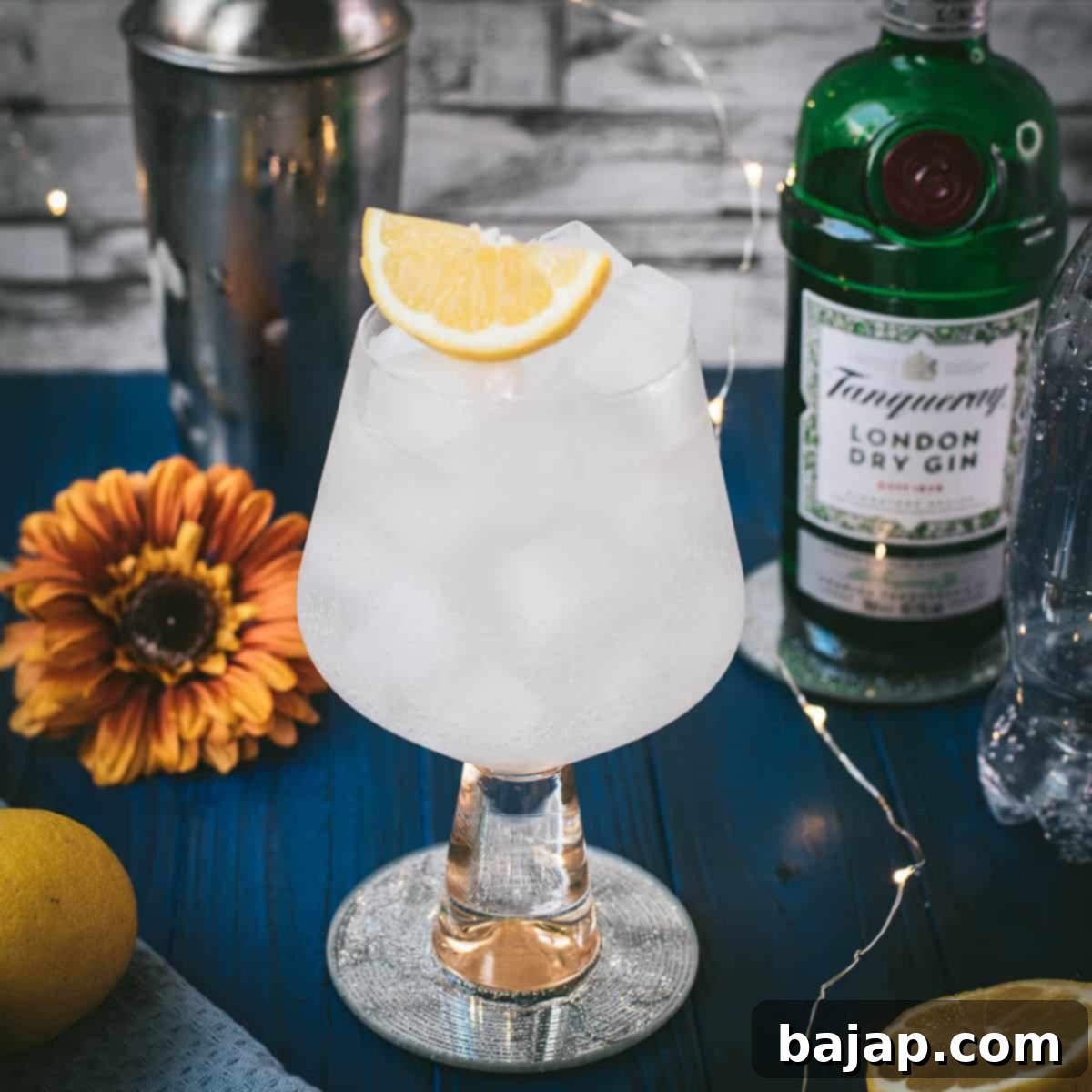The Ultimate Refreshing Lemon Gin and Tonic Recipe: Your Zesty Summer Sip
If your heart beats for the bright, vibrant tang of lemons over the subtler notes of limes, prepare to discover your new favorite cocktail! This Lemon Gin and Tonic recipe is a true delight – wonderfully sweet, crisp, and bursting with citrus. It’s the quintessential summer cocktail, perfectly suited for unwinding on a warm evening or celebrating with friends.
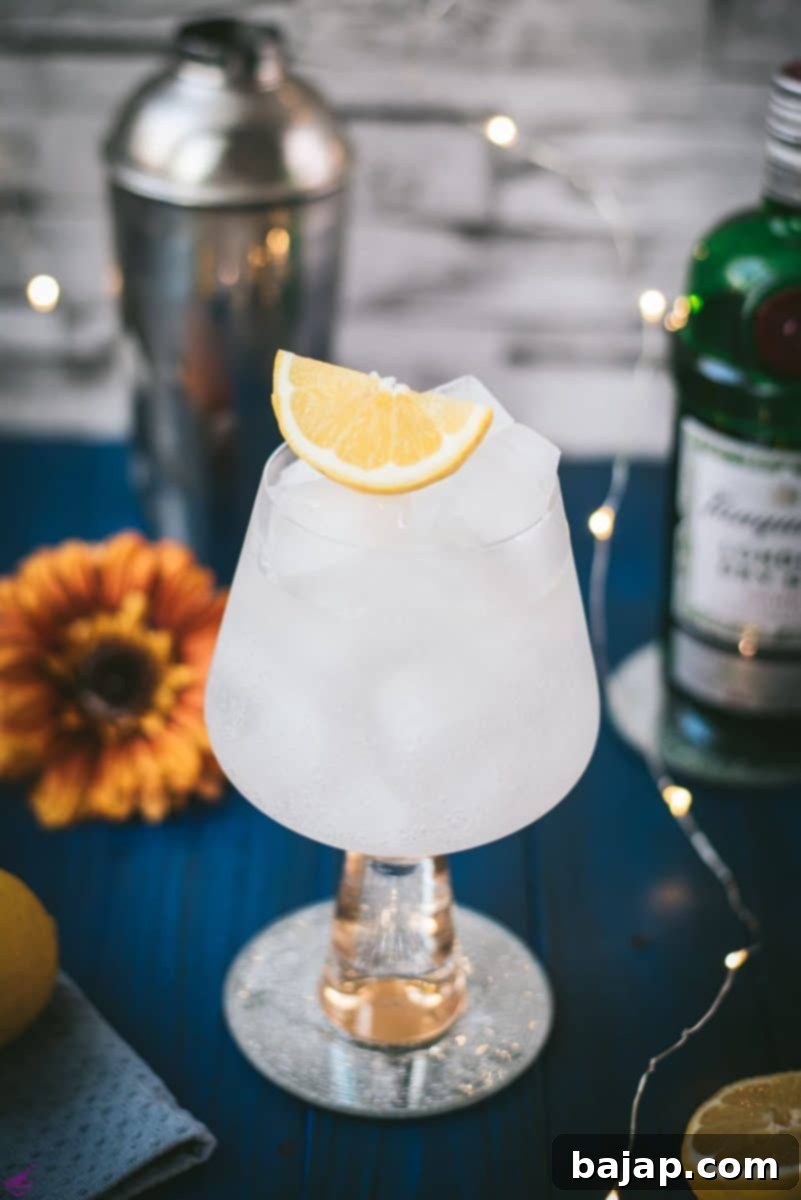
While the classic gin and tonic with lime holds an iconic status for good reason, a special place in my heart is reserved for the zesty lemon gin and tonic. In fact, it was the very first cocktail I mastered during my bartending school days. Through this experience, I gained a deep appreciation for the inherent simplicity and incredible versatility of this gin cocktail.
As someone who genuinely enjoys showering friends and family with warm hospitality, I particularly love how much room this lemon gin and tonic recipe offers for customization. It allows me to tailor drinks to suit my guests’ individual tastes or even match the theme of an occasion. The world of gin and tonic is vast and exciting, with numerous gin varieties and tonic types, leading to countless delicious combinations.
Beyond its customizable nature, another significant advantage of this drink is how remarkably quick and easy it is to prepare. This means I spend less precious time shaking and stirring behind the bar and more quality time enjoying the company of my loved ones. It’s truly a win-win situation for any host!
Don’t forget: National Gin and Tonic Day is celebrated on April 9th!
🎥 Watch How It’s Made: Video Guide
🥘 Essential Ingredients for Your Lemon Gin and Tonic
Crafting the perfect Lemon Gin and Tonic starts with selecting high-quality ingredients. Here’s a breakdown of what you’ll need and some tips for choosing the best of each.
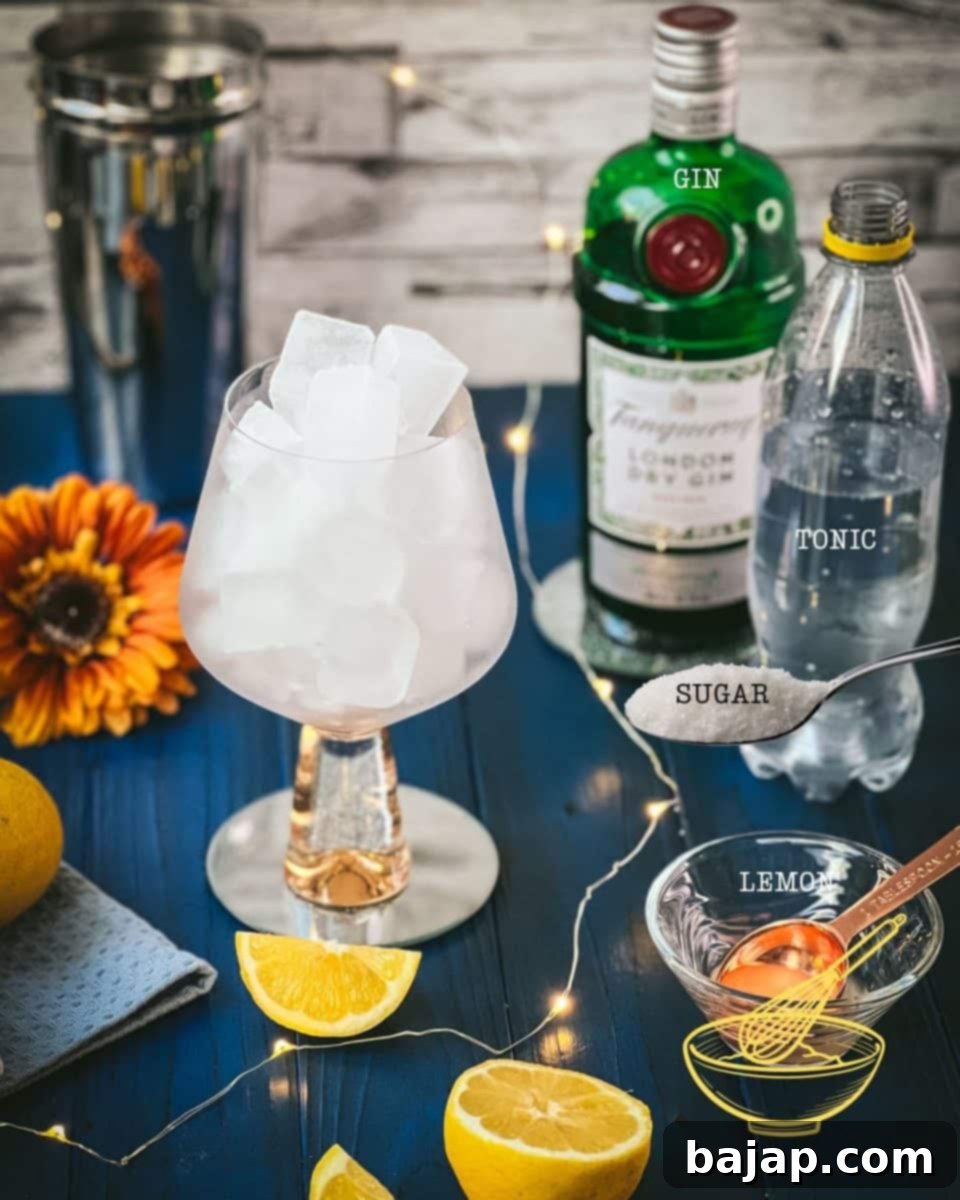
- Ice Cubes: The more, the merrier! Fill your glass to the brim for optimal chilling and slower dilution. Large ice spheres or cubes are excellent for this.
- Gin of Your Choice: This is where you can truly personalize your drink. For a lemon gin and tonic, a classic London Dry Gin with prominent juniper notes works beautifully, allowing the lemon to shine. However, feel free to experiment with a more citrus-forward gin or even a floral gin for a unique twist.
- Fresh Lemon Juice: Always opt for freshly squeezed lemon juice! Bottled juice simply doesn’t compare in terms of flavor and aroma. One average lemon yields about 2-3 tablespoons of juice, so have a couple on hand.
- Granulated Sugar: A touch of sugar helps balance the tartness of the lemon, creating that wonderfully sweet and crisp profile. You can also use simple syrup for easier blending.
- Tonic Water: The other half of the dynamic duo. Choose a good quality tonic water. There are many options available, from classic Indian tonic to more botanical or light varieties. The tonic’s bitterness will play a crucial role in the overall balance of your drink.
- Lemon Slice or Wedge and Drinking Straw for Garnish: Not just for looks, a fresh lemon garnish adds an extra aromatic dimension to your cocktail. A reusable straw is a great eco-friendly touch!
For precise measurements, please refer to the detailed recipe card at the end of this article.
🍹 Step-by-Step Guide to Crafting Your Lemon Gin and Tonic
As cocktails go, this one is wonderfully straightforward, making it perfect for both novice and experienced home bartenders. Let’s get mixing!
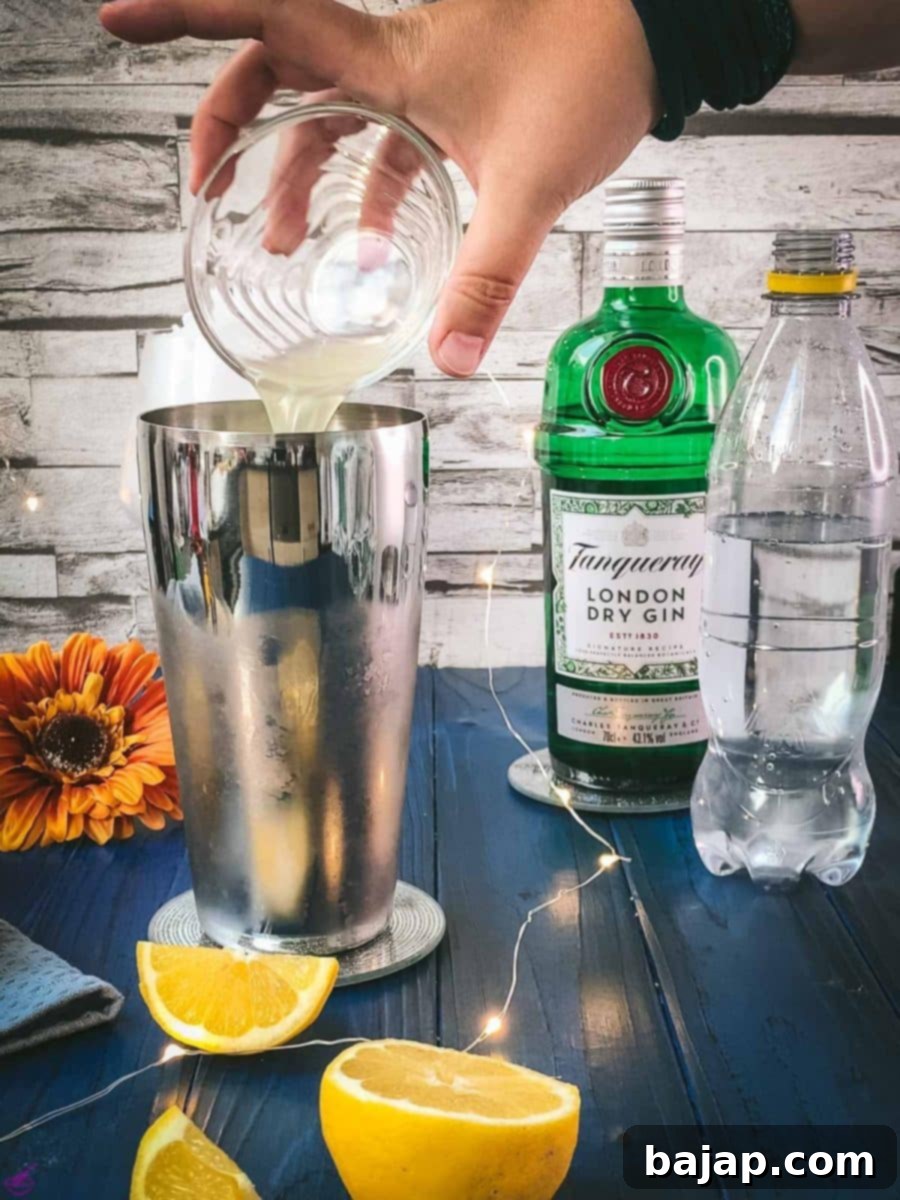
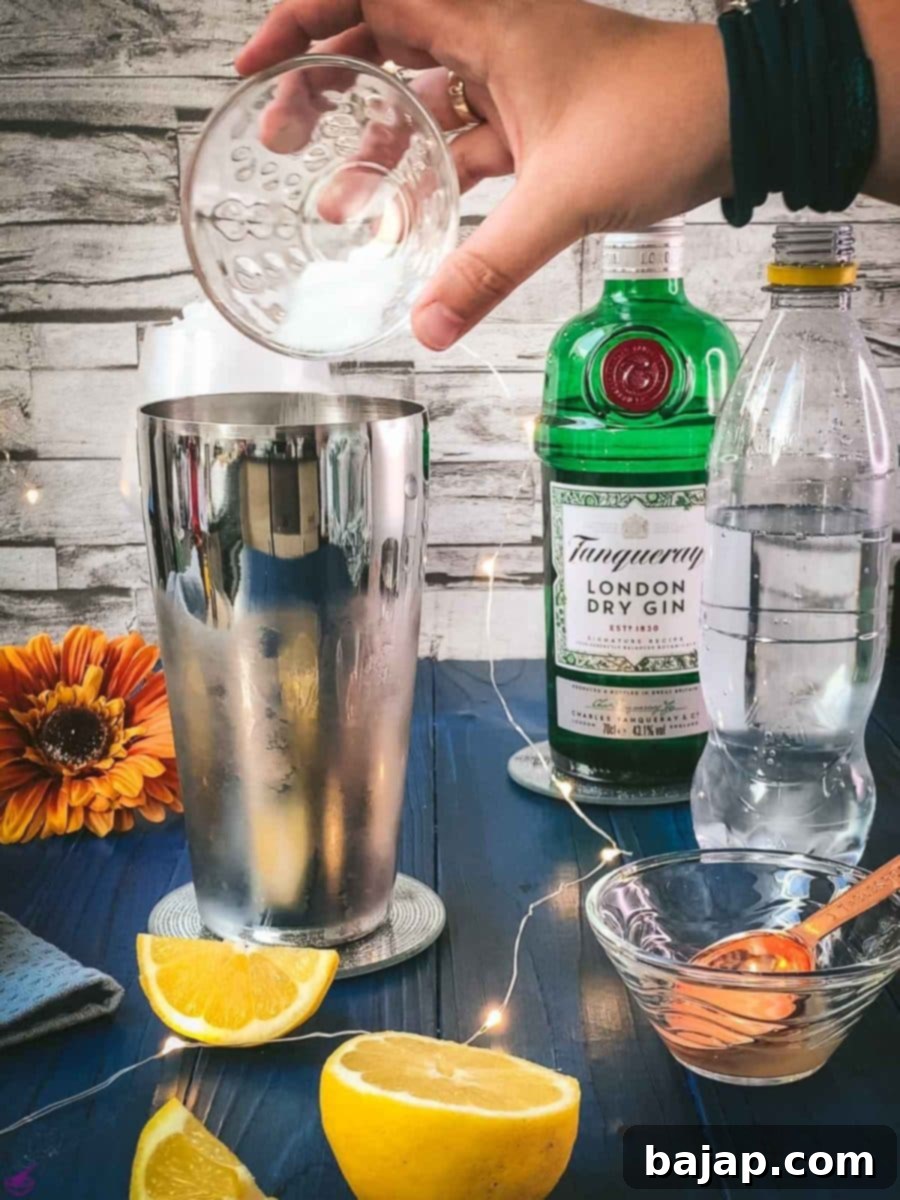
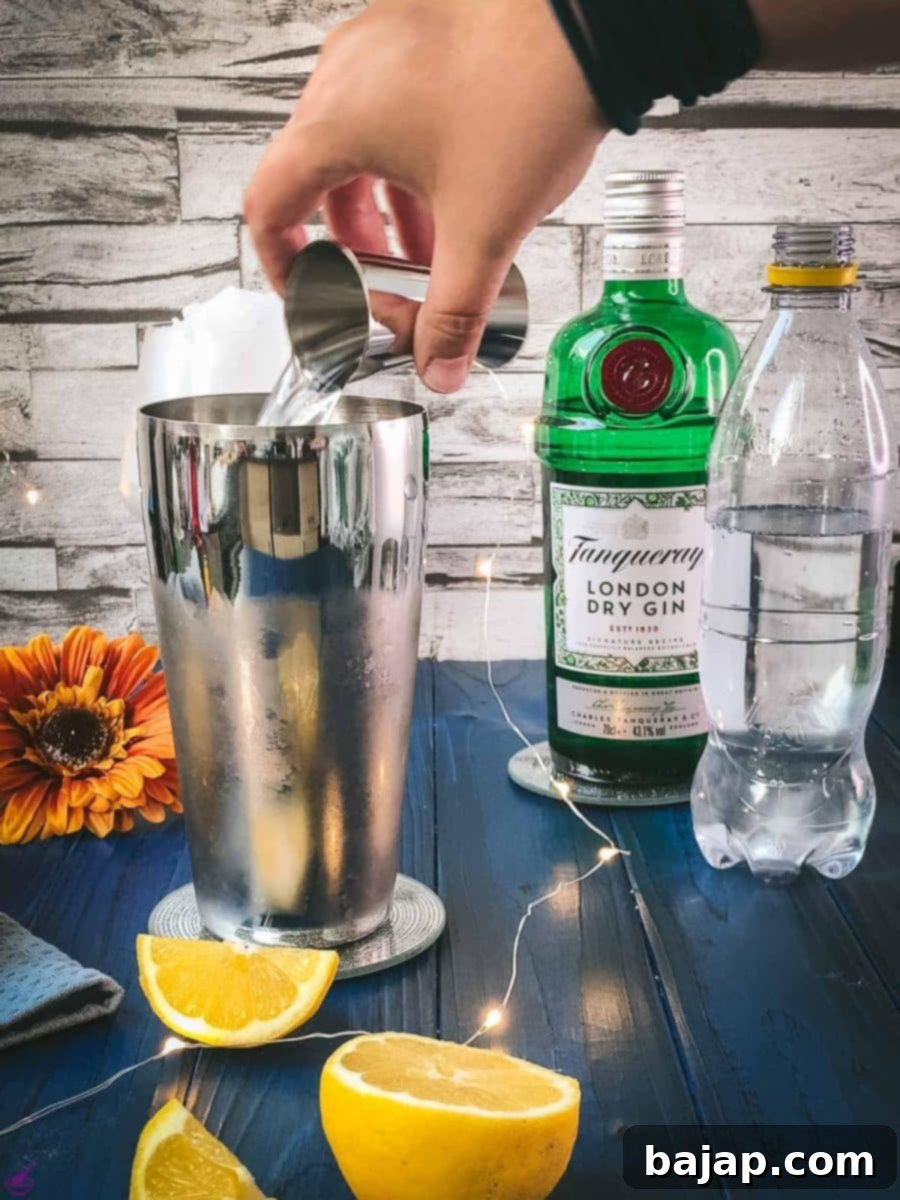
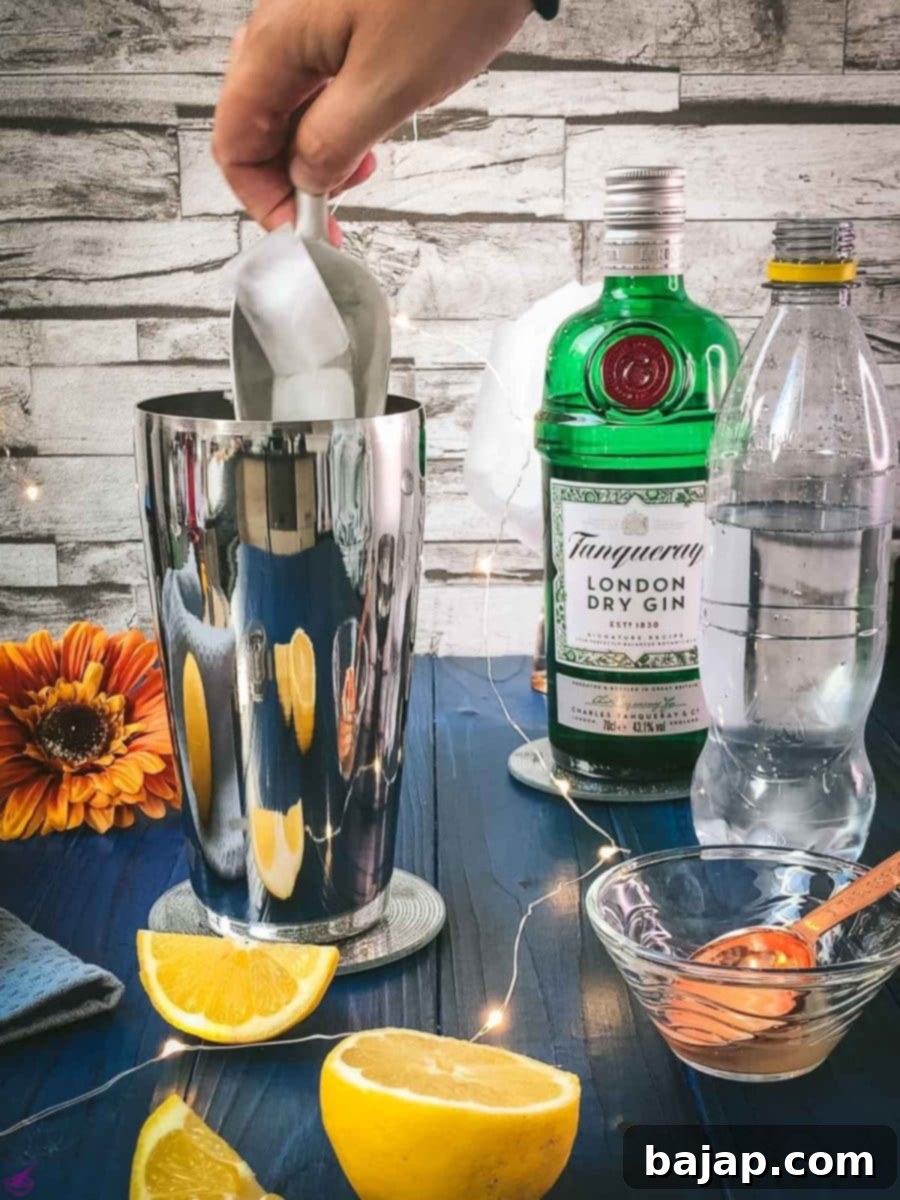

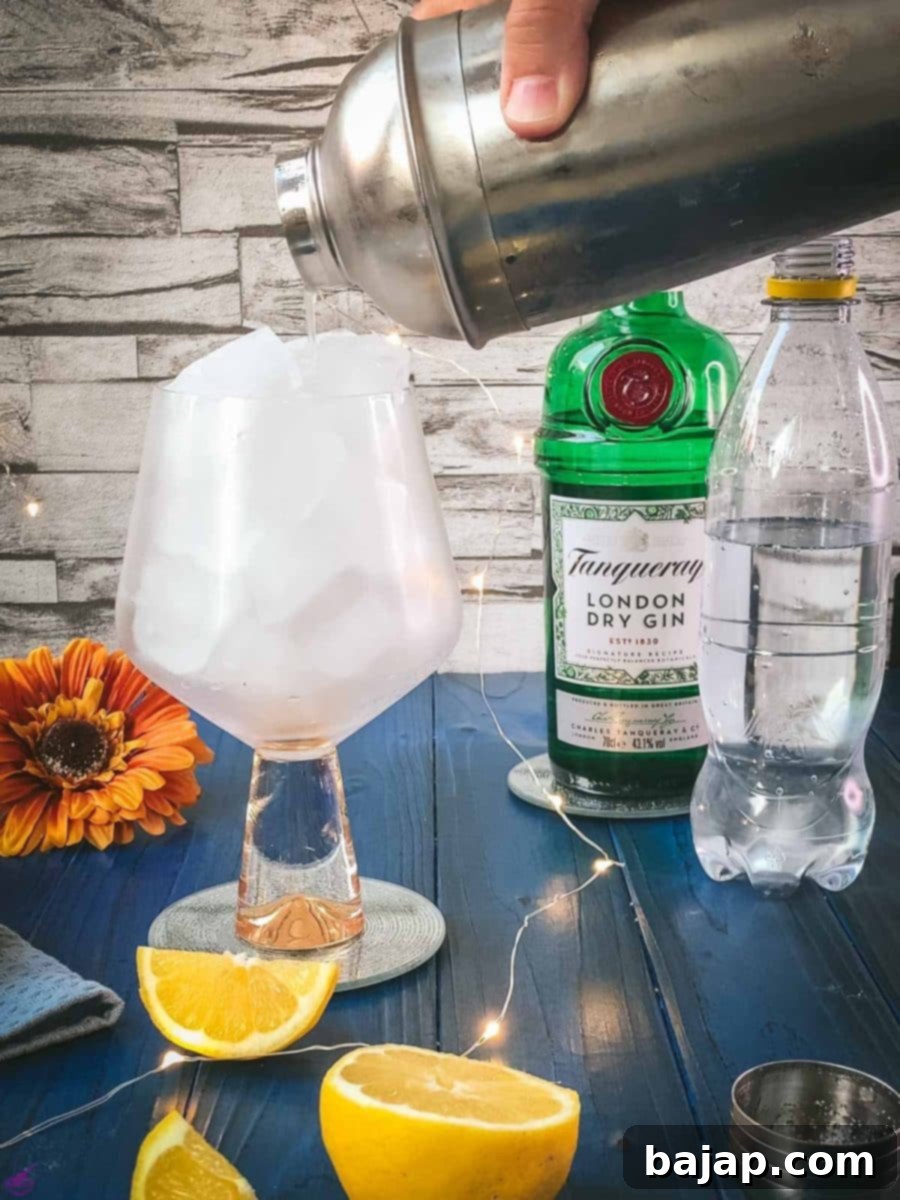
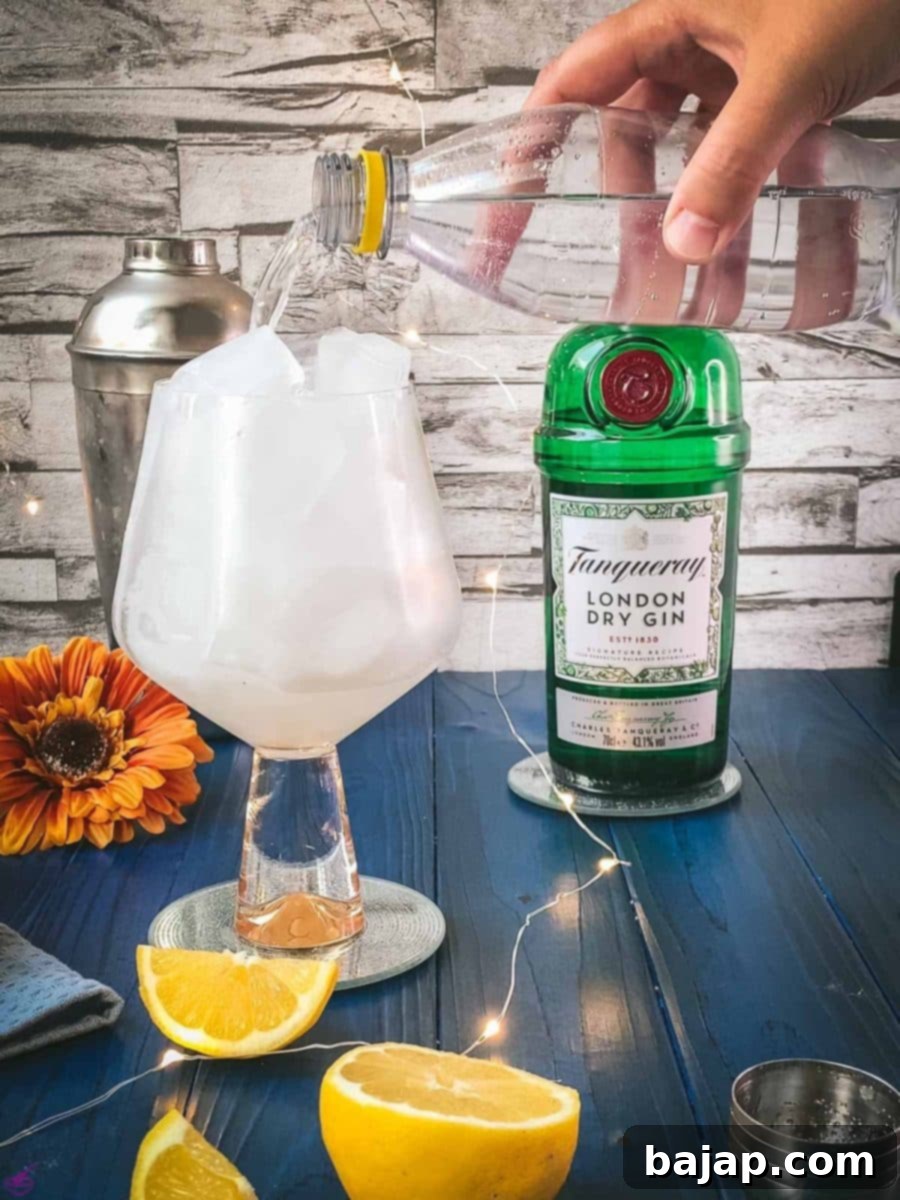
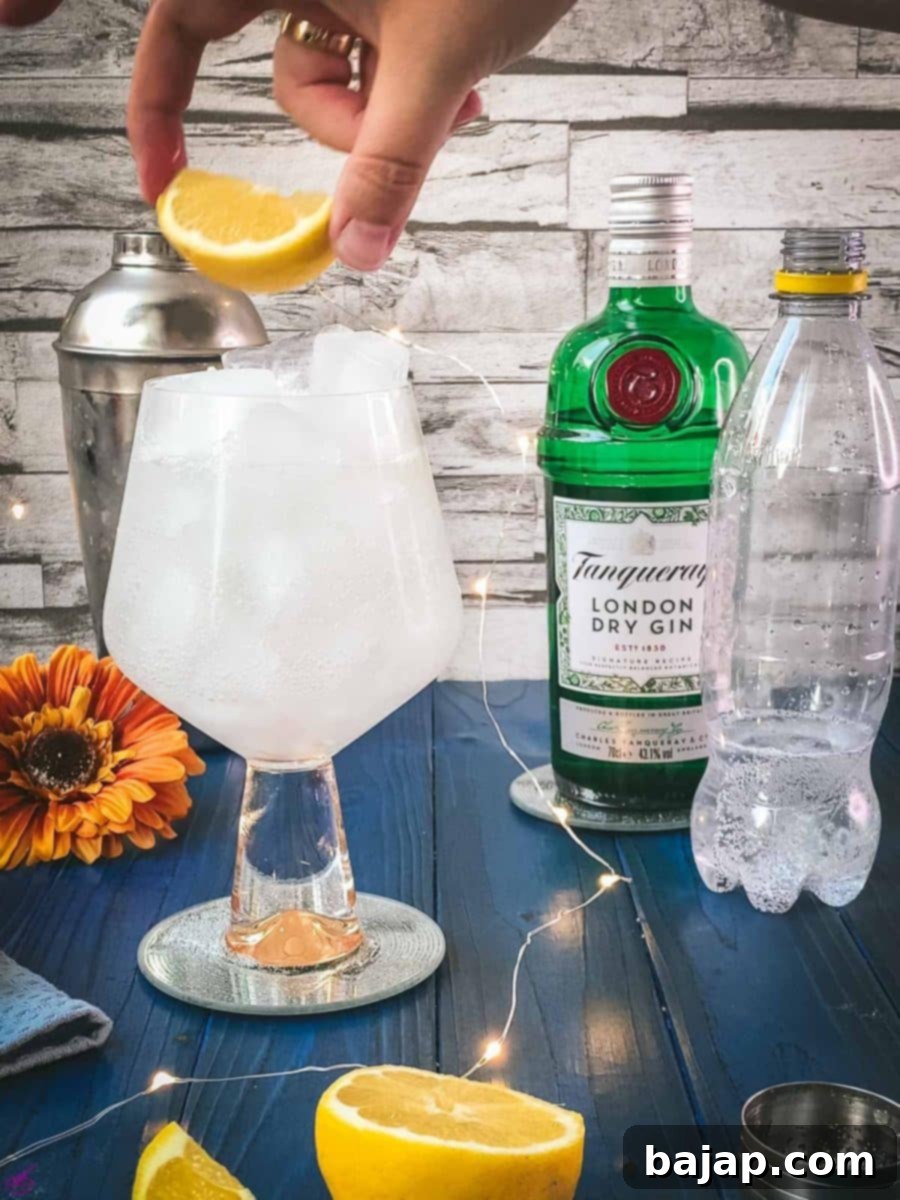
🔪 Detailed Instructions for a Perfect Lemon Gin and Tonic
This refreshing cocktail recipe is remarkably simple and quick to assemble, making it ideal for impromptu gatherings or a relaxing evening at home.
- Prepare Your Citrus: Start by squeezing half of a fresh lemon. You’ll need about 1 tablespoon of lemon juice, but having a little extra is always a good idea. Freshness is key here!
- Combine Ingredients in Shaker: Into a cocktail shaker, add 1 tablespoon of freshly squeezed lemon juice, 1 teaspoon of granulated sugar (or simple syrup for a smoother dissolve), 1 ½ oz of your preferred gin, and a generous amount of ice.
- Shake It Up: Secure the lid of your shaker and mix vigorously. Shaking not only chills the ingredients rapidly but also helps to dissolve the sugar and slightly dilute the gin and lemon, ensuring a well-balanced flavor. Personally, I find the rhythm of Gloria Estefan and the Miami Sound Machine’s “Conga” chorus provides the perfect timing for a good shake! Aim for about 15-20 seconds.
- Chill Your Glass: While shaking, or even beforehand, fill your chosen glass – a highball or a balloon glass works best – to the brim with fresh ice. Pre-chilling your glass in the freezer beforehand ensures your drink stays colder longer and dilutes slower.
- Pour and Strain: Once your ingredients are well mixed and thoroughly chilled, pour the contents of the shaker over the ice in your prepared glass. If you’re using a Boston shaker, employ a julep strainer to hold back the ice from the shaker, allowing only the liquid to flow into your glass.
- Top with Tonic: Fill the remaining space in your glass with tonic water. A standard highball glass typically holds between 1 cup (240 ml) to 1 ½ cups (350 ml), so there will be ample room for the tonic after adding your gin and lemon mixture. Pour gently to preserve the tonic’s effervescence.
- Garnish and Serve: Finally, complete your masterpiece with a fresh lemon wedge or wheel and a fun, reusable drinking straw. The citrus garnish adds an aromatic boost with every sip!
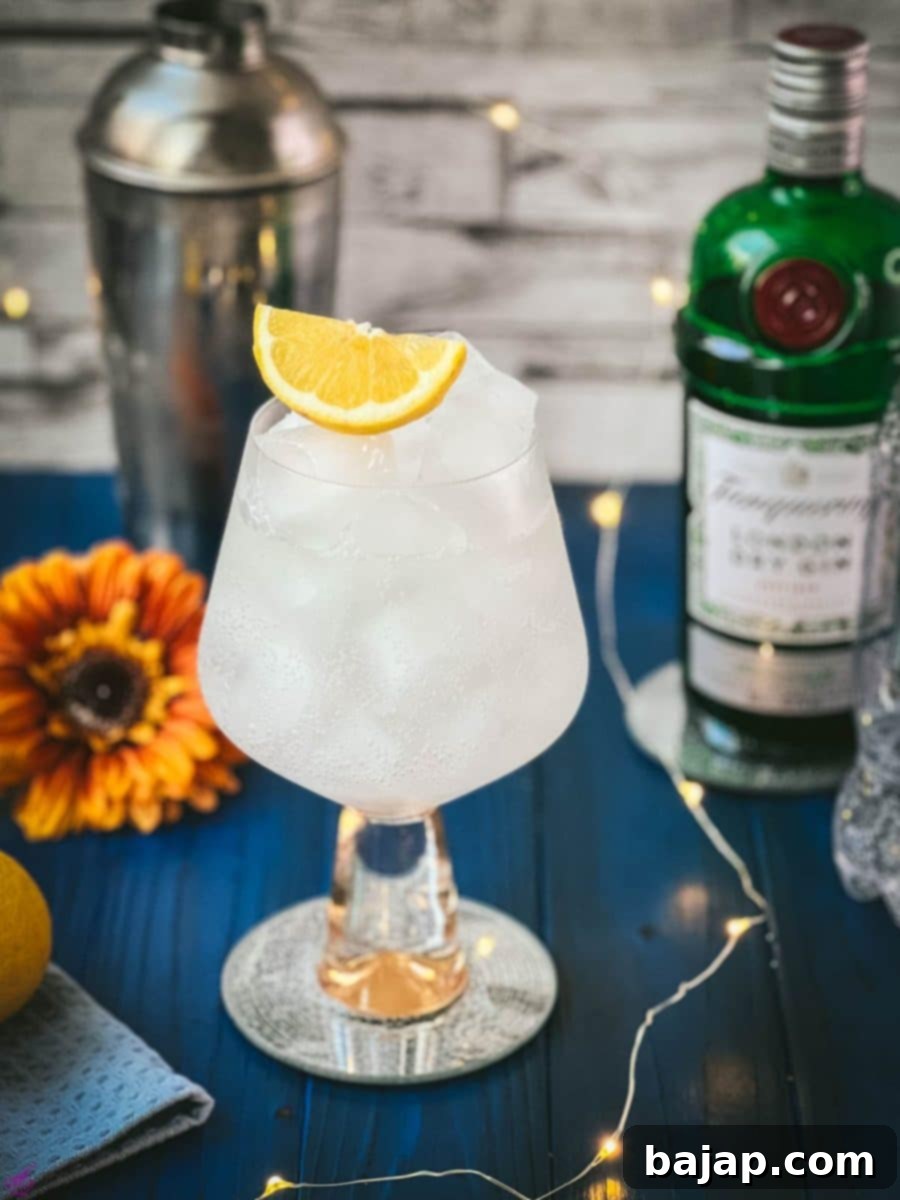
🍋 Explore Exciting Variations for Your Lemon Gin and Tonic
One of the joys of a gin and tonic is its incredible adaptability. While this classic lemon version is fantastic, don’t hesitate to experiment and make it your own!
- Adjusting Sweetness: If you find the fresh lemon a bit too tart, or if you simply prefer a sweeter profile, an extra dash of granulated sugar or a small amount of simple syrup (equal parts sugar and water, heated until sugar dissolves, then cooled) can work wonders. Start small and taste as you go.
- Gin Selection: The world of gin varieties is vast. Consider a New Western gin with less prominent juniper notes, allowing the lemon to mingle with other botanicals like coriander or citrus peels. A more floral gin could add a delightful complexity.
- Tonic Exploration: Just as with gin, there’s a wide range of tonic varieties. Try a Mediterranean tonic for herbal notes, a floral tonic for a fragrant twist, or a dry tonic if you prefer less sweetness overall. Your choice of tonic can dramatically alter the drink’s character.
- Beyond Lemon: While this recipe champions lemon, you can easily introduce other citrus. Grapefruit provides a wonderful bittersweet note, while orange adds a softer, sweeter touch. For an aromatic garnish, a sprig of rosemary or thyme can elevate the experience.
- Herbaceous Touches: Muddle a few fresh mint leaves, basil, or even a slice of cucumber in the shaker with your gin and lemon juice before shaking for an extra layer of freshness.
- Fruity Infusions: For a burst of summer flavor, muddle a few fresh raspberries or blueberries with the lemon juice and sugar before adding gin and ice.
For an in-depth dive into all things gin and tonic, including extensive details on pairing gins with tonics, be sure to check out our comprehensive Gin & Tonic Guide!
🍽 Essential Bar Equipment for Your Lemon G&T
Having the right tools makes all the difference when crafting cocktails. Here’s what you’ll need for your Lemon Gin and Tonic:
- Jigger: A jigger is essential for accurately measuring your spirits and other liquid ingredients, ensuring a consistent and perfectly balanced cocktail every time.
- Cocktail Shaker: A reliable cocktail shaker is key for properly chilling and combining your ingredients. It also helps to slightly dilute the drink and dissolve the sugar.
- Lemon Squeezer: To get the most juice out of your fresh lemons with minimal effort and mess. Fresh juice is crucial for the best flavor!
- Julep Strainer: This is particularly useful if you’re using a Boston shaker, allowing you to pour the liquid while holding back the ice and any muddled ingredients.
- Highball Glass or Balloon Glass (Chilled): The classic choices for a gin and tonic. A highball is tall and slender, while a balloon glass (also known as a Copa glass) is wider, allowing more room for ice and aromatic garnishes. Always serve in a chilled glass to maintain the drink’s temperature and effervescence longer.
🌡 Storage: Enjoy Immediately for Best Flavor
A truly exceptional Lemon Gin and Tonic is meant to be savored as soon as it’s prepared. Unlike some other cocktails, this refreshing drink does not fare well when stored for later consumption. The primary reason for this is the tonic water. Tonic is a carbonated beverage, and like all fizzy drinks, it will inevitably lose its effervescence over time. A flat gin and tonic loses its signature crisp, lively, and refreshing character that it’s so famously known for. The delicate balance of flavors will also begin to degrade, making it less enjoyable. For the ultimate experience, mix, garnish, and sip right away!
💭 Pro Tips for the Perfect Gin and Tonic
Elevate your Lemon Gin and Tonic experience with these expert tips:
- Handle Glasses with Care: When preparing your gin and tonic cocktails, always hold your highball or balloon glasses from the bottom or stem. Avoid touching the rim or the main body of the glass with your warm hands. This simple practice helps to keep your already chilled glass nice and cool, which is paramount for a truly refreshing and long-lasting cocktail. The colder the glass, the slower your ice will melt, leading to less dilution and a better-tasting drink.
- The Art of Chilling: Wondering how to achieve that perfectly chilled glass? The most efficient method is to place your glasses in the freezer beforehand. I typically recommend at least a half-hour, but if you’re planning a summer backyard grilling session or dinner party, you can even pop them in the night before. A frozen glass will dramatically enhance your drink.
- Quality Ice Matters: Don’t underestimate the power of good ice! Large, dense ice cubes or spheres melt slower than small, crushed ice, meaning your drink stays cold without getting watered down too quickly. Consider investing in an ice mold for impressive, slow-melting cubes.
- Eco-Friendly Sipping: To protect our environment, I strongly encourage you to avoid using disposable plastic straws whenever possible. Instead, opt for reusable alternatives like metal or paper straws, or simply enjoy your delightful drink without one altogether!
🙋🏻 Frequently Asked Questions About Lemon Gin and Tonics
This is a delightful debate that truly comes down to personal preference! While lime is the traditional garnish for many gin and tonic recipes, lemon offers a distinctively bright, sweet, and zesty flavor profile that many people adore. Personally, I lean towards a lemon gin and tonic for its vibrant acidity and unique twist, but there are plenty of gin enthusiasts who might consider that preference sacrilegious! If you’re undecided, why not craft both a lemon and a lime gin and tonic at home and host your own tasting party to discover your favorite?
The iconic addition of lime to the gin and tonic has a fascinating historical root. It was first introduced in the 19th Century to quinine (a prophylactic against malaria), primarily to help make the bitter medicinal drink more palatable. Soldiers and colonialists in tropical regions needed to consume quinine regularly, and adding citrus like lime, along with sugar, made it far more enjoyable. Somewhere along the way, they started adding gin to the mix, and the cocktail has since become wildly popular, with the lime garnish becoming a beloved tradition. If you’re curious to learn more about the rich and intriguing history behind the gin and tonic cocktail, be sure to check out our in-depth gin and tonic guide!
Quinine is an alkaloid historically used as a prophylactic against malaria, known for its distinct bitter taste. Tonic water, as we know it today, is essentially a carbonated beverage that contains a small amount of quinine. It was originally developed to make the medicinal quinine more palatable, particularly for British officers in India. Gin was later added to this quinine-infused tonic to create the classic cocktail. So, “quinine tonic and gin” refers to the core components of the gin and tonic drink – gin mixed with tonic water, which contains quinine and is often balanced with sugar and other flavors to temper its bitterness.
Ideally, with a refreshing twist and in good company! The beauty of a gin and tonic is its versatility. While I absolutely adore this vibrant lemon gin and tonic recipe for its bright and zesty kick, there are countless ways to enjoy it. You might also find our cucumber gin and tonic recipe pretty darn tasty for a cool, botanical variation. The key is to serve it well-chilled, with plenty of ice, and garnished with a complementary citrus or botanical. Experiment with different gins and tonics to find your perfect match!
For a lemon gin and tonic, a classic London Dry Gin is often an excellent choice. Its prominent juniper and citrus notes create a harmonious balance with the fresh lemon. However, for a unique twist, consider a more citrus-forward gin where lemon or orange peels are key botanicals, which will amplify the lemony freshness. If you prefer something a bit softer or more complex, a New Western Style gin might introduce interesting herbal or floral notes that pair beautifully with lemon without overpowering it. Ultimately, the “best” gin is the one you enjoy most!
OTHER REFRESHING RECIPES FOR YOU TO TRY
- Strawberry Spritz Cocktail: A sweet and bubbly treat perfect for celebrations.
- Refreshing Lavender Daiquiri: A fragrant and floral twist on a classic.
- Cucumber Gin and Tonic: Crisp, cool, and incredibly refreshing for hot days.
- Homemade Vodka Sidecar: A sophisticated and tangy classic with a vodka base.
- Lovely Lavender Spritz Cocktail: Light, floral, and elegantly simple.
- Vanilla Vodka and Tonic: A surprisingly smooth and aromatic variation on the tonic theme.
If you try this delightful Lemon Gin and Tonic recipe, I would absolutely love to hear from you! Please let me know how you liked it by giving it a ★★★★★ star rating and leaving a comment below. Your feedback is truly awesome and helps others discover great recipes! You can also sign up for our Newsletter to receive weekly delicious homemade recipes directly in your inbox, or follow me on Pinterest or Instagram and share your beautiful creation with me. Just tag me @combinegoodflavors and use the hashtag #combinegoodflavors, so I don’t miss seeing your amazing drink!
📖 Recipe

Refreshing Lemon Gin and Tonic
Nora
Save RecipeSaved!
Pin Recipe
Equipment
-
Jigger
-
Cocktail shaker
-
Lemon squeezer
-
Julep strainer if you are using a Boston shaker
-
Highball Glass or balloon glass
Ingredients
- Cubed Ice
- 1 ½ oz Your favorite gin
- 1 tablespoon Lemon juice
- 1 teaspoon Granulated sugar
- 1 cup Tonic to fill up the glass
- Lemon wedge and drinking straw for garnish
Instructions
-
Squeeze half a lemon and add 1 tablespoon Lemon juice, 1 teaspoon Granulated sugar, and 1 ½ oz Your favorite gin to your shaker filled with ice cubes.1 ½ oz Your favorite gin, 1 tablespoon Lemon juice, 1 teaspoon Granulated sugar
-
Close the shaker and shake well.
-
Fill the glass with Cubed IceCubed Ice
-
Then pour the mix directly into the cocktail glass filled with ice cubes. If using a Boston shaker, strain the mix through a julep strainer.
-
Fill up with 1 cup Tonic (one high ball glass holds 240 ml (1 cup) to 350 ml(1 ½ cups)).1 cup Tonic
-
Lemon wedge and drinking straw for garnishLemon wedge and drinking straw for garnish
Nutrition values are estimates only, using online calculators. Please verify using your own data.

🤎 You might also like
- Vanilla Vodka and Tonic
- The Complete Guide to Gin & Tonic
- Refreshing Cucumber Gin and Tonic
- How do you make a Frozen Strawberry Daiquiri
⛑️ Food Safety Guidelines
Ensuring food and drink safety is paramount for a worry-free experience. Please keep these general guidelines in mind:
- Cook all foods to a minimum internal temperature of 165 °F (74 °C) to eliminate harmful bacteria.
- Avoid using the same utensils on cooked food that have previously touched raw meat or poultry to prevent cross-contamination.
- Always wash your hands thoroughly with soap and water after handling raw meat or other raw ingredients.
- Do not leave perishable food or beverages sitting out at room temperature for extended periods, as this can encourage bacterial growth.
- Never leave cooking food unattended, even for a short time, to prevent accidents and ensure proper cooking.
- When cooking, use oils with a high smoking point to avoid the production of harmful compounds and maintain food quality.
- Always ensure good ventilation when using a gas stove or other cooking appliances to prevent the buildup of fumes.
For more comprehensive and specific information on food safety, please refer to reliable sources such as Safe Food Handling – FDA.
